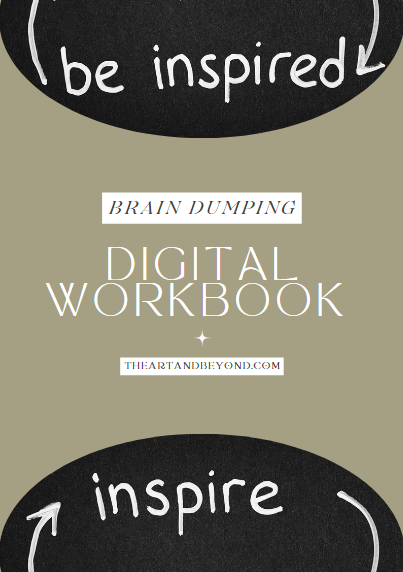If you haven’t thought about it already, brain dumps can be a great way to generate inspiration and content ideas. And in this article, I am going to share with you how you can easily make the most out of your brain dumps, turning them into inspiration and content ideas for your creative career.
Let’s start with brain dumps and what they mean
Brain dumps stand for the act of writing down everything (in the literal meaning of the term) that comes to mind. Take it as getting all of your thoughts and ideas down on paper and freeing up space in your brain.
To do this, you need to have a journal or planner on hand at all times. Or you can use a digital planner or an app such as Workflow or TickTick. And although for a brain dump to effectively work, you may need to write down all the thoughts that come to mind about a specific topic, I honestly find it more meaningful to just write down everything.
You can buy this brain dump digital workbook I made to go along with this article here.
So, how can we turn these scraps of brain dumps into inspiration/content?
Review your brain dump
Don’t treat this process like a chore. Only do brain dumps when you start feeling like you’re obsessively overthinking about a specific topic, or if you feel like your mind is getting foggy and crowded. Then, once a week or so, take a look at what you’ve written and try to identify common themes or topics that stand out. Highlight or circle anything that catches your eye.
Here’s a personal example:
The previous month, I started painting again in oil paint after a very long time. As I was painting, all I could think about was the painting process and how tricky oil paint is after a while of no practice. Later those days, whenever I sat down to journal or do a brain dump, I would write things like, I have a slight headache from being exposed to chemical solvents while painting for longer hours, from which I came up with the idea of figuring out how to paint with no chemical solvents and turned that into a blog post. In the same way, I posted an article about how to achieve realistic skin tones in oil, a detailed guide to oil paint mediums for beginners, and many more. Those were all brain dumps turned into pieces of content.
Group similar ideas together
Once you’ve identified common themes, group similar ideas together. This will help you see patterns and connections that you may not have noticed before.
Identify potential content formats
Think about the type of content that would work best for the ideas you’ve grouped together. For example, would a blog post, video, infographic, or podcast be the best way to convey your message?
Another thing to keep in mind is that for content to be taken into consideration, it has to serve either of these goals:
- Educational content
- Solving a problem
- Aspirational content
- Shareable content
- Inspirational content
- Photos
- Your process
- Entertaining content
- Storytelling
Refine your ideas
Take some time to refine your ideas and think about how you can make them more interesting and engaging. Consider adding a unique perspective or angle, including personal experiences or examples, or using storytelling to make your content more relatable.
Create a content calendar
Once you have a list of refined ideas, create a content calendar to help you stay organized and on track. Consider factors like the best time to publish, the frequency of your content, and how you’ll promote it.
Practical explanation
Let’s say you have a brain dump about your experiences with mindfulness and meditation. You’ve written down a lot of different ideas, including the benefits of mindfulness, the challenges of maintaining a meditation practice, and how to incorporate mindfulness into your daily life.
To turn these ideas into inspiration and content, you might do the following:
- Read through your notes and identify the key themes that stand out to you, such as the benefits of mindfulness and the challenges of maintaining a meditation practice.
- Group all the benefits of mindfulness into one category and all the challenges of maintaining a meditation practice into another.
- Write a blog post about the benefits of mindfulness, create a video series on different meditation techniques, or share tips for incorporating mindfulness into your daily routine on social media (depending on your medium).
- include personal stories or examples of how mindfulness has impacted your life, or share research and statistics to back up the benefits of mindfulness.
- Get a content calendar to help you stay organized and on track. You might schedule a blog post about the benefits of mindfulness for next week, plan a video series on different meditation techniques for the following month, and brainstorm social media posts to share throughout the week.
By following these steps, you can turn your brain dumps into a valuable source of inspiration for creating engaging and informative content.




5 Comments